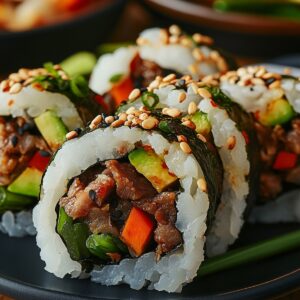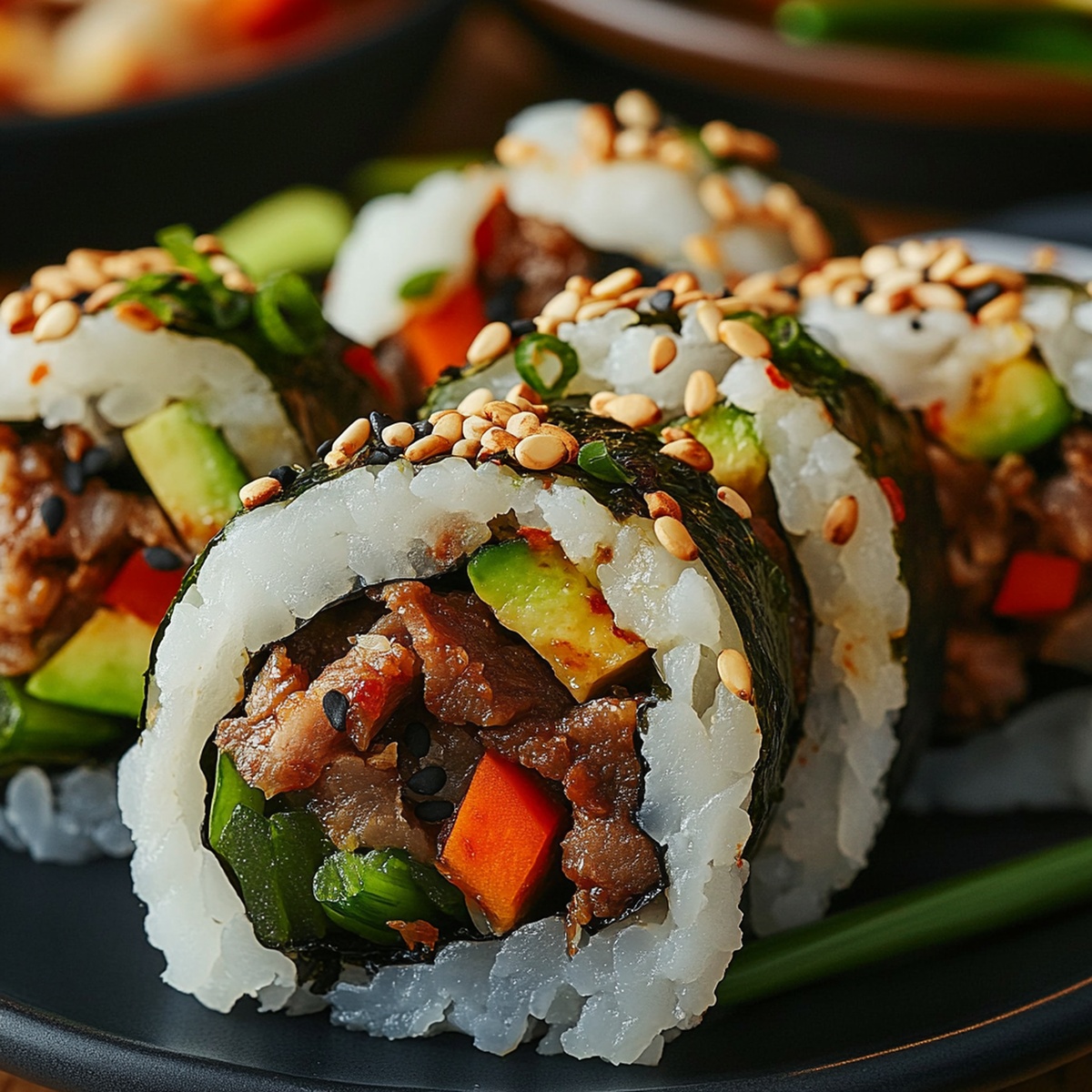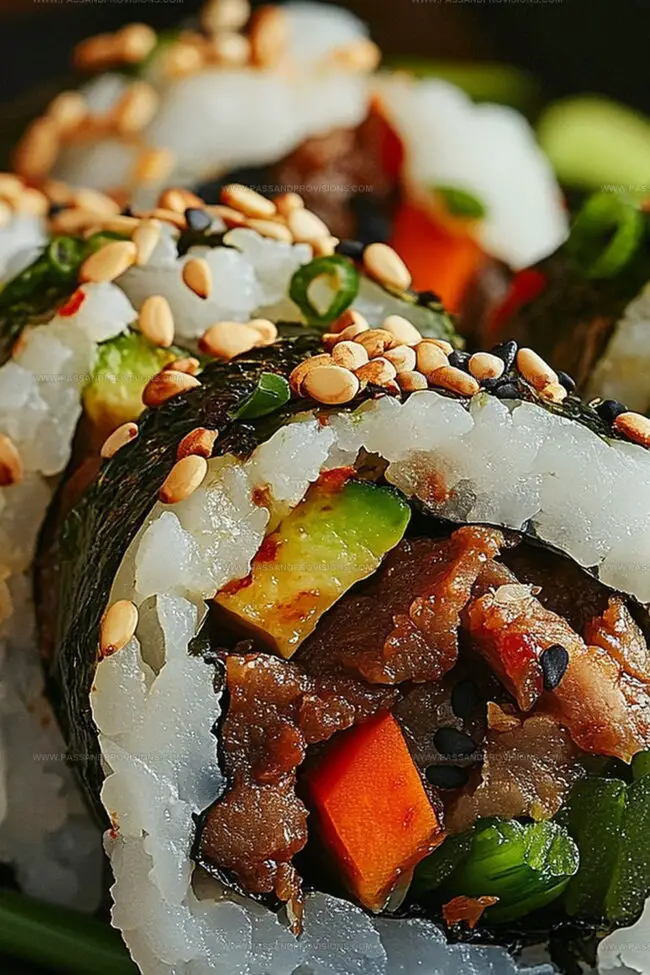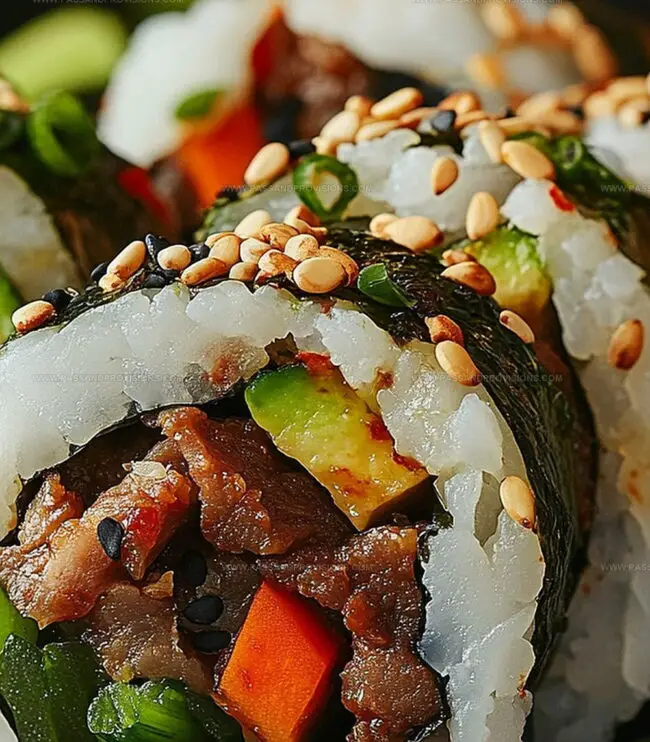Irresistible Korean Bulgogi Sushi Rolls Recipe for Beginners
Tender strips of marinated beef dance through authentic Korean bulgogi sushi rolls, creating an irresistible fusion of flavors.
Sushi lovers adore this innovative twist on traditional recipes.
Bold Korean spices mingle with delicate rice and nori wrap.
The marinade infuses each bite with deep, complex notes of soy and garlic.
Succulent meat pairs perfectly with crisp vegetables inside these elegant rolls.
Slicing reveals layers of vibrant ingredients that tempt every sense.
These sushi rolls promise a delectable journey through Korean and Japanese culinary traditions.
Quick Recipe Overview
What You Need for Korean Bulgogi Sushi Rolls
For Marinade and Seasoning:For Sushi Components:For Protein and Egg:Sushi Roll Equipment for Marinated Bulgogi Beef
Instructions to Craft Korean Bulgogi Rolls at Home
Combine zesty soy sauce, sweet brown sugar, fragrant sesame oil, tangy rice vinegar, crushed garlic, grated ginger, cracked black pepper, nutty sesame seeds, and chopped green onions in a bowl.
Toss sliced beef into the marinade and let it soak up flavors for 30 minutes or overnight for a deeper taste explosion.
Fire up a pan on medium-high heat and cook the beef until it caramelizes and turns golden brown, creating a mouthwatering crust.
Stir rice vinegar, sugar, and salt into warm cooked rice, mixing gently to create a perfectly seasoned base.
Lay a nori sheet on a bamboo mat, shiny side facing down, ready for your culinary masterpiece.
Using damp hands, layer a thin blanket of rice across the nori, leaving a tiny border at the top.
Arrange succulent bulgogi, crisp cucumber, vibrant carrots, creamy avocado, and optional perilla leaves in a tempting line near the bottom. Tuck in some delicate omelet strips for extra pizzazz.
Embrace the sushi mat and roll tightly from the bottom, applying gentle pressure to create a perfect cylindrical wonder.
Moisten the edge to seal, then slice into eight elegant pieces using a sharp, wet knife.
Sprinkle with sesame seeds and serve alongside zingy soy sauce or spicy gochujang mayo for an epic flavor journey.
Fillings and Add-Ons to Customize Your Sushi
Serve Bulgogi Rolls With Pickled Veggies or Sauce
Store Korean Sushi Rolls to Retain Freshness
Print
Mouthwatering Korean Bulgogi Sushi Rolls Recipe
- Total Time: 30 minutes
- Yield: 5 1x
Description
Sizzling Korean bulgogi sushi rolls blend savory marinated beef with delicate rice, creating a perfect fusion of Korean and Japanese culinary traditions. Crisp vegetables and tangy sauce wrap rich flavors into compact, irresistible bites you’ll crave again and again.
Ingredients
- ½ lb (226.8 g) ribeye or sirloin, thinly sliced
- 2 tbsps soy sauce
- 1 tbsp brown sugar
- 1 tbsp sesame oil
- 1 tsp rice vinegar
- 1 tsp minced garlic
- ½ tsp grated ginger
- ½ tsp black pepper
- 1 tsp sesame seeds
- 1 green onion, finely chopped
- 2 cups sushi rice, cooked
- 1 ½ tbsps rice vinegar
- 1 tsp sugar
- ½ tsp salt
- 5 sheets nori
- 1 small cucumber, julienned
- 1 small carrot, julienned
- 1 avocado, sliced
- 34 perilla leaves (optional)
- 1 egg, cooked into thin omelet and sliced (optional)
- Sesame seeds
- Soy sauce
- Gochujang mayo or spicy sriracha mayo
Instructions
- Marinate Bulgogi: Blend soy sauce, brown sugar, sesame oil, rice vinegar, garlic, ginger, black pepper, sesame seeds, and green onion. Immerse sliced beef and let infuse for 30 minutes, allowing flavors to penetrate deeply.
- Sear Beef: Ignite a skillet over medium-high flame. Caramelize beef to golden perfection, creating rich, intense flavor profiles. Transfer protein to a holding plate.
- Craft Sushi Rice: Whisk rice vinegar, sugar, and salt in a compact vessel. Integrate mixture into warm rice, gently folding to distribute seasoning evenly. Allow rice to cool and stabilize.
- Construct Sushi Canvas: Position nori sheet on bamboo mat with glossy surface facing downward. Delicately spread rice across surface, maintaining a precise border at the top edge.
- Layer Ingredients: Strategically arrange bulgogi, cucumber, carrot, avocado, perilla leaves, and omelet strips in a precise linear formation near bottom periphery.
- Execute Roll Technique: Leverage bamboo mat to compress and rotate sushi, applying gentle, consistent pressure. Seal terminus with minimal water, ensuring structural integrity.
- Finalize Presentation: Utilize a razor-sharp, moisture-laden knife to segment roll into elegant portions. Garnish with sesame seeds and accompany with complementary soy sauce or gochujang mayo.
Notes
- Let beef absorb flavors for maximum taste, preferring overnight marination for deeper, richer flavor profile.
- Ensure rice is warm but not hot when mixing vinegar mixture to prevent soggy texture and maintain perfect sticky consistency.
- Always use a wet knife when slicing sushi rolls to prevent rice and ingredients from sticking, creating clean, professional-looking cuts.
- Pat beef dry after marinating to ensure proper caramelization and prevent excess liquid during cooking, which can prevent browning.
- Prep Time: 15 minutes
- Cook Time: 15 minutes
- Category: Lunch, Dinner, Snacks
- Method: Frying
- Cuisine: Korean
Nutrition
- Serving Size: 5
- Calories: 320
- Sugar: 5 g
- Sodium: 600 mg
- Fat: 10 g
- Saturated Fat: 2 g
- Unsaturated Fat: 6 g
- Trans Fat: 0 g
- Carbohydrates: 40 g
- Fiber: 3 g
- Protein: 15 g
- Cholesterol: 70 mg




William Hawkins
Founder & Culinary Director
Expertise
Education
Sullivan University, Louisville, KY
William Hawkins isn’t just a chef, he’s a storyteller through food. From his hometown of Louisville, KY, he’s spent years refining his craft, turning local ingredients into something extraordinary.
With classical training from Sullivan University and a career marked by innovation, mentorship, and Southern soul, William approaches every recipe with purpose. His kitchen is where old techniques meet fresh ideas, and where comfort food gets a thoughtful, modern twist.
When he’s not building dishes from the ground up, he’s out gathering inspiration from nature, markets, and the stories people share around the table.